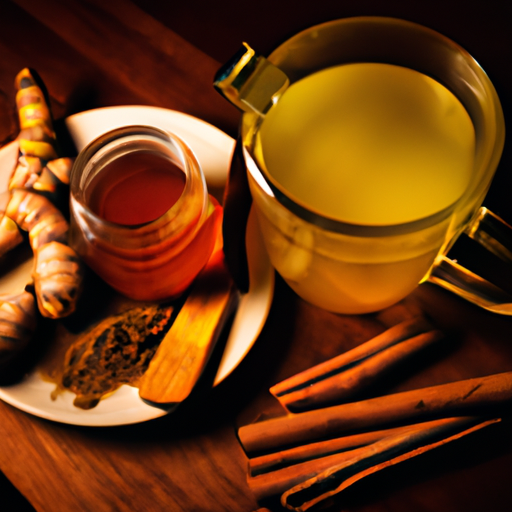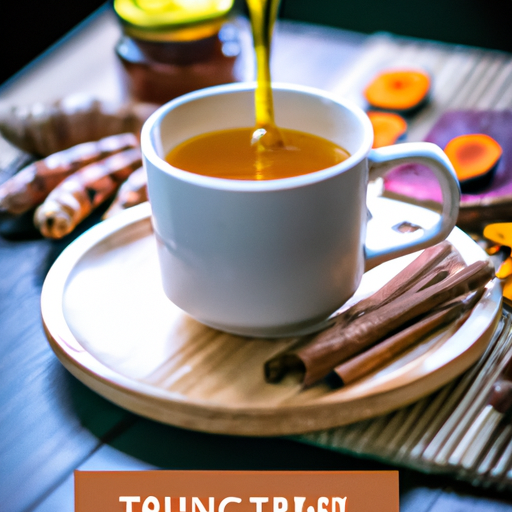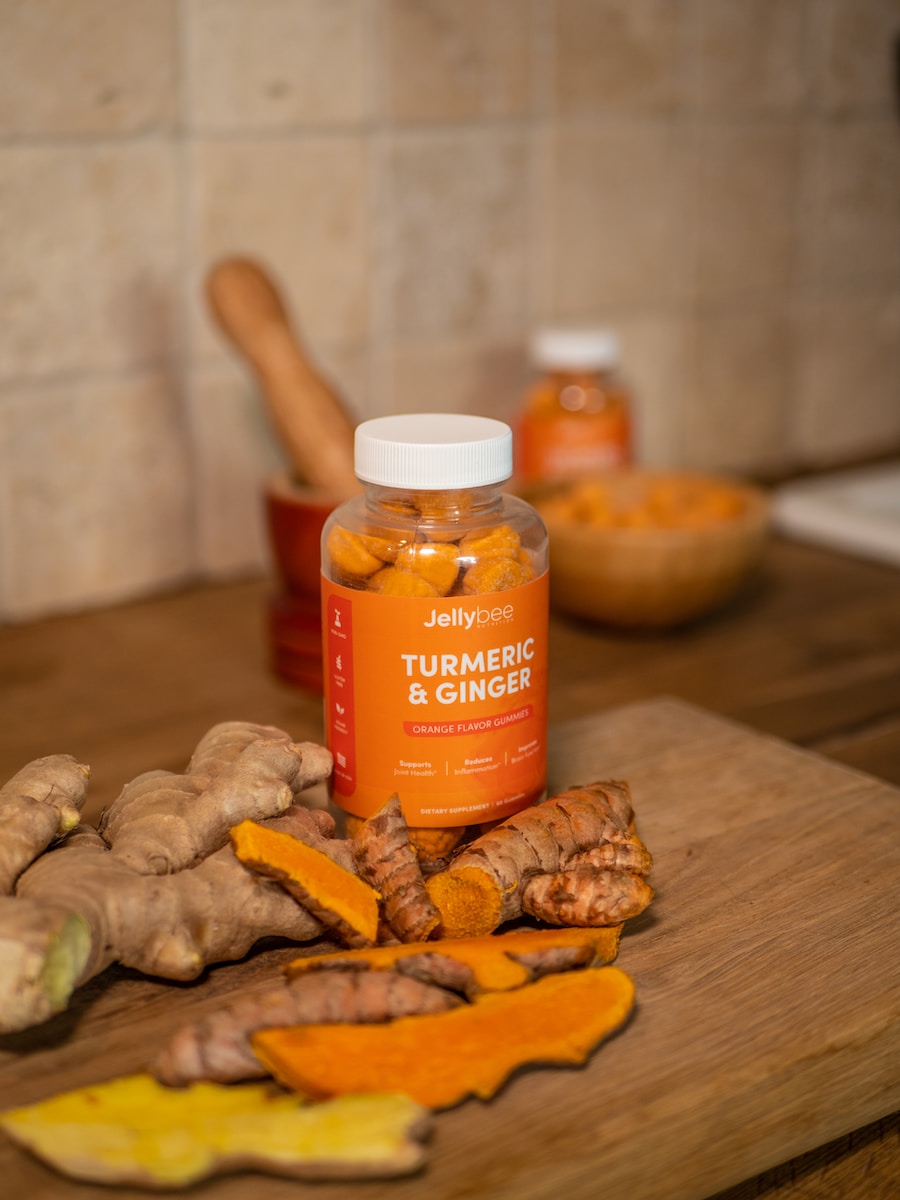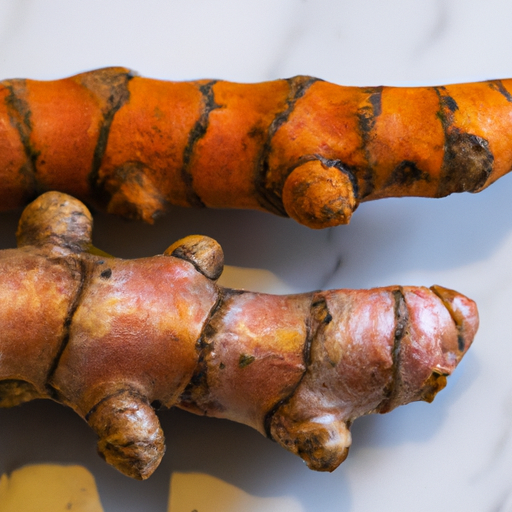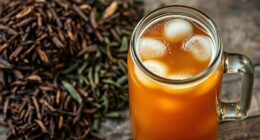I found a secret weapon in my battle against inflammation, and I’m excited to share it with you! Turmeric, this **golden gem** of a spice, isn’t just for adding flavor to your meals. It’s been a superstar in ancient healing practices for ages and now, everyone’s talking about it for a good reason. Its power to fight inflammation is just mind-blowing.
One of my favorite ways to incorporate turmeric into my diet is by making a warm cup of turmeric tea. Making turmeric tea is simple, affordable, and offers a multitude of health benefits.
In this article, I will be sharing everything you need to know about how to make turmeric tea for inflammation. From the ingredients you need to the potential side effects, I will provide an evidence-based guide that will help you enjoy the many benefits of this powerful spice.
So grab your mug and let’s get started!
Key Takeaways
- Turmeric tea offers numerous health benefits, including anti-inflammatory and antioxidant properties.
- To make turmeric tea, you need turmeric powder or grated turmeric root, freshly grated ginger or ginger powder, black pepper powder, and optional honey, lemon juice, and/or milk.
- Precautions should be taken when consuming turmeric tea, such as limiting the amount to one cup per day and consulting with a healthcare provider before incorporating into your diet.
- Turmeric can also be incorporated into other recipes like turmeric latte or added to smoothies for additional health benefits.
What is Turmeric and How Does it Help with Inflammation?
If you’re looking to reduce inflammation, turmeric can be a powerful ally thanks to its active compound curcumin. Turmeric is a bright yellow-orange spice that originated in India and has been used in traditional medicine for centuries. Curcumin, which gives turmeric its vibrant color, is known for its potent anti-inflammatory and antioxidant properties.
In traditional medicine, turmeric has been used to treat various ailments such as digestive issues, skin problems, respiratory illnesses, and even cancer. It’s also commonly used as a natural pain reliever due to its ability to reduce inflammation.
Research has shown that curcumin can inhibit the activity of inflammatory enzymes and cytokines in the body, thereby reducing inflammation.
Now that we know how turmeric helps with inflammation, let’s dive into how we can make our own turmeric tea at home using some simple ingredients.
Ingredients You Need for Turmeric Tea
To prepare this anti-inflammatory drink, you’ll need a few simple ingredients that can be found in most kitchens. Don’t forget to grab some fresh ginger and black pepper as they play an essential role in enhancing turmeric’s healing properties. Here are the ingredients you will need for your cup of turmeric tea:
| Ingredients | Amount |
|---|---|
| Turmeric powder or grated turmeric root | 1-2 teaspoons or 1/2 inch piece |
| Freshly grated ginger or ginger powder | 1/2-1 teaspoon or 1/2 inch piece |
| Black pepper powder | A pinch or 1/8 teaspoon |
| Honey, lemon juice, and/or milk (optional) | To taste |
Turmeric tea variations are endless and depend on personal preference. You can add other spices such as cinnamon, nutmeg, or cardamom to make it more flavorful. Some people also like to use coconut milk instead of regular milk for a creamier texture.
If you don’t have the time to make your own turmeric tea at home, there are several brands that offer pre-packaged tea bags with high-quality ingredients. Some of the best turmeric tea brands include Pukka Herbs, Yogi Tea, and Traditional Medicinals.
Now that you know what ingredients are needed for making turmeric tea and different variations available, let’s move on to how to make this delicious drink.
How to Make Turmeric Tea
Get ready to indulge in a delicious cup of golden goodness with this simple recipe for turmeric tea. Making turmeric tea is easy, and there are several recipes you can follow.
One popular recipe involves boiling water with grated or ground turmeric, ginger, and honey. You can also add other ingredients like black pepper, cinnamon, or lemon juice to enhance the flavor.
To make turmeric tea using the first recipe, start by bringing one cup of water to a boil in a small saucepan. Add one teaspoon of grated or ground turmeric and half a teaspoon of grated ginger to the boiling water. Reduce the heat and let it simmer for about five minutes.
Then strain the mixture into a mug and add honey to taste. Turmeric tea benefits are numerous and include reducing inflammation, boosting immunity, improving digestion, relieving pain, promoting healthy skin, among others.
In the next section, we’ll explore these health benefits in more detail. So go ahead and sip on your warm cup of turmeric tea while enjoying its many therapeutic effects!
Health Benefits of Turmeric Tea
I love drinking turmeric tea because of its amazing health benefits. Not only does it have anti-inflammatory properties, but it also helps improve digestion and boost the immune system.
Turmeric tea is a practical and easy way to incorporate this powerful spice into your daily routine for optimal health.
Anti-inflammatory Properties
Turmeric is known to possess anti-inflammatory properties, making it a popular ingredient in traditional medicine. Inflammation is the body’s natural response to injury or infection, but chronic inflammation can lead to various health problems such as arthritis, heart disease, and even cancer.
Turmeric contains curcumin, which has been shown to have potent anti-inflammatory effects that rival some pharmaceutical drugs. In fact, studies have found that turmeric can help reduce inflammation in conditions such as osteoarthritis and rheumatoid arthritis. It may also be useful in preventing and treating other inflammatory diseases like Alzheimer’s disease and diabetes.
Incorporating turmeric into your diet through natural remedies or dietary supplements can be a simple way to support your overall health and wellbeing.
Besides its anti-inflammatory benefits, turmeric has numerous other health benefits worth considering. For instance, it has antioxidant properties that protect against cell damage caused by free radicals. Additionally, research suggests that turmeric may improve brain function, lower the risk of heart disease, aid digestion, and even potentially prevent certain types of cancer.
With all these potential benefits in mind, adding turmeric to your daily routine might just be one of the best things you can do for your health!
Other Health Benefits
You’ll be pleased to know that incorporating turmeric into your meals can potentially offer other health benefits besides its anti-inflammatory properties.
Turmeric supplements have been found to lower cholesterol levels and reduce the risk of heart disease. Additionally, the curcumin in turmeric has been shown to improve brain function and possibly even prevent cognitive decline.
Another potential benefit of turmeric is for skin health. Some studies have found that applying a turmeric-based cream or mask can help with conditions such as acne, eczema, and psoriasis. While more research is needed in this area, it’s worth considering adding some turmeric to your skincare routine if you struggle with these skin issues.
As we’ve seen, there are many reasons to incorporate turmeric into your diet beyond just its anti-inflammatory properties. But how much should you consume? Let’s explore that next.
How Much Turmeric Tea Should You Drink?
Ideally, you should aim to consume about two to three cups of turmeric tea per day to experience the anti-inflammatory benefits. This amount has been suggested as a safe and effective daily intake by various health experts. However, it’s important to note that this is just a recommended dosage and may vary depending on individual needs.
When consuming turmeric tea, it’s also important to be mindful of possible risks associated with an overdose. While turmeric is generally considered safe, excessive amounts can lead to gastrointestinal discomfort such as nausea and diarrhea. In some cases, high doses may even cause liver damage or other serious health problems.
To avoid any potential negative side effects, it’s best to start with a small amount of turmeric tea and gradually increase your intake over time if necessary. As with any dietary supplement or herbal remedy, it’s always wise to consult with your healthcare provider before making any significant changes in your daily routine.
While drinking two to three cups of turmeric tea per day can provide numerous anti-inflammatory benefits for your body, it’s important to exercise caution when starting out. Keeping in mind the recommended dosage and possible risks associated with an overdose will help ensure that you’re enjoying all the advantages without putting yourself at risk for any unwanted side effects.
Next up, we’ll talk about precautions and side effects so you know what else you need to take into consideration when incorporating turmeric tea into your diet.
Precautions and Side Effects
Before jumping into consuming turmeric tea, it’s important to be aware that high doses can lead to gastrointestinal discomfort, liver damage, and other serious health problems. So, it’s crucial to consult with your healthcare provider before incorporating it into your diet. It’s alarming to know that excessive amounts of turmeric can cause harmful effects on the body.
To avoid any adverse reactions, it’s recommended to stick to a moderate amount of turmeric tea per day. The ideal amount is one cup per day, especially if you’re new to consuming turmeric. If you experience any side effects like nausea or diarrhea after drinking turmeric tea, discontinue use immediately and seek medical attention.
It’s also important to note that turmeric may interact with certain medications like blood thinners and anti-inflammatory drugs. Therefore, if you’re taking any medication regularly, talk with your healthcare provider before adding turmeric tea into your diet.
In addition, pregnant women should avoid consuming large amounts of turmeric as it may stimulate contractions and increase the risk of miscarriage.
Now that we’ve discussed precautions and side effects associated with drinking turmeric tea for inflammation relief, let’s explore other ways you can incorporate this spice into your daily routine without putting yourself at risk for potential harm.
Other Ways to Incorporate Turmeric into Your Diet
There are plenty of delicious and creative ways to add turmeric to your meals and snacks, giving you a flavorful boost while also supporting your overall health. One popular way to enjoy turmeric is by making a turmeric latte, also known as golden milk. This warm and cozy drink is made with turmeric, cinnamon, ginger, black pepper, and coconut milk or almond milk. You can sweeten it with honey or maple syrup for an extra touch of flavor.
Another tasty option is adding turmeric to your smoothies. Simply blend together some frozen fruits like banana, pineapple, or mango with fresh greens like spinach or kale. Then add a pinch of ground turmeric and some freshly squeezed lemon juice for an extra burst of vitamin C. You can also add other spices like ginger or cinnamon for added flavor.
Incorporating more turmeric into your diet doesn’t have to be complicated or time-consuming. With just a few simple tweaks to your favorite recipes, you can enjoy the benefits of this powerful spice in no time.
Now that we’ve explored some other ways to use turmeric in cooking and drinks, let’s dive into different recipes for making our own anti-inflammatory tea blends at home!
Turmeric Tea Recipes for Different Needs
Now that we’ve explored different ways to incorporate turmeric into our diets, let’s dive deeper into one specific method: making turmeric tea. Turmeric tea is a delicious and easy way to reap the benefits of this powerful spice. Plus, it’s versatile – you can customize your recipe based on your specific needs.
There are various turmeric tea variations that you can try depending on what you want to achieve. For example, if you’re looking for a relaxing bedtime drink, try adding chamomile or lavender to your turmeric tea recipe. Alternatively, if you’re seeking a boost in energy, consider mixing in some ginger or lemon for an extra kick.
Not only does turmeric tea taste great, but it also offers numerous benefits for skin health. Curcumin, the active ingredient in turmeric, has anti-inflammatory properties which can help reduce redness and inflammation in the skin. Additionally, curcumin has been shown to improve collagen production and promote wound healing – both crucial factors in maintaining healthy skin. So next time you’re looking for a tasty way to support your skin health, reach for a cup of homemade turmeric tea!
| Turmeric Tea Variation | Benefits |
|---|---|
| Turmeric Ginger Tea | Boosts digestion and reduces inflammation |
| Turmeric Green Tea | Promotes weight loss and supports heart health |
| Turmeric Cinnamon Tea | Helps regulate blood sugar levels |
Incorporating these ingredients into your daily routine through drinking homemade turmeric tea is an excellent way to benefit from their unique properties while enjoying a warm and comforting beverage at the same time. Experiment with different flavors until you find the perfect blend that works best for your body’s needs!
Frequently Asked Questions
Is it safe to consume turmeric tea while pregnant or breastfeeding?
As a pregnant or breastfeeding individual, it’s natural to be concerned about the safety of consuming certain foods and beverages. When it comes to turmeric tea, there are some safety precautions you should keep in mind.
While there is limited research on the effects of turmeric during pregnancy and breastfeeding, it may stimulate the uterus and potentially lead to complications. As with any new food or beverage, it’s important to consult with your healthcare provider before adding turmeric tea to your diet.
That being said, turmeric has been shown to have potential benefits for reducing inflammation and boosting immunity. If you do decide to consume turmeric tea while pregnant or breastfeeding, be sure to do so in moderation and under the guidance of your healthcare provider.
Can turmeric tea interact with any medications?
When it comes to turmeric tea, it’s important to be aware of potential drug interactions and dosage restrictions. Turmeric can interact with certain medications, including blood thinners and diabetes drugs. Therefore, if you’re taking any medication, it’s best to consult with your healthcare provider before incorporating turmeric tea into your diet.
Additionally, while turmeric is generally considered safe in small amounts, consuming large quantities may lead to digestive issues or worsen existing conditions such as gallbladder disease. It’s always recommended to follow dosage instructions and start with a small amount before gradually increasing intake.
Can turmeric tea be consumed in large quantities?
When it comes to turmeric tea, like anything else, moderation is key. While there are numerous health benefits associated with consuming turmeric tea, including reducing inflammation and potentially preventing chronic diseases such as cancer and Alzheimer’s, it’s important to be aware of the recommended dosage.
The ideal amount per day is around 500-2000mg of curcumin, the active ingredient in turmeric. Consuming large quantities can lead to potential side effects such as upset stomach or even ulcers.
As with any supplement or medication, it’s important to consult with a healthcare provider before adding turmeric tea to your routine if you have any pre-existing conditions or take medications that could interact negatively. Overall, drinking turmeric tea in moderation can provide a range of health benefits without posing significant risks as long as proper precautions are taken.
How long does turmeric tea stay fresh and how should it be stored?
Storing turmeric tea is crucial to maintain its freshness and shelf life. Let’s be honest, no one wants to drink stale turmeric tea that tastes like dirt! To ensure maximum flavor and potency, I recommend storing your turmeric tea in an airtight container away from direct sunlight or heat sources.
This will prevent the delicate compounds within the tea from breaking down and losing their effectiveness. As for how long it stays fresh, it really depends on the quality of the ingredients used and how well it’s stored. Generally speaking, homemade turmeric tea can last up to a week when stored properly in the fridge.
So, if you want to enjoy a flavorful cup of turmeric tea every day without compromising on taste or health benefits, make sure you store it correctly!
Can turmeric be replaced with another spice in the recipe for turmeric tea?
Spice alternatives and recipe variations are always an option when making tea. There are many spices that can replace turmeric in the recipe for turmeric tea, such as ginger, cinnamon, or cardamom. Each spice has its unique flavor profile and health benefits, so it’s a matter of personal preference which one you choose.
When experimenting with recipe variations, it’s essential to keep in mind that some spices may require less or more quantity than turmeric to get the desired taste. It’s also important to note that the health benefits associated with turmeric may not be present when using other spices. So, if you’re looking for a specific medicinal effect, it’s best to research which spice will provide that benefit before making any substitutions.
Conclusion
So that’s how I make my turmeric tea for inflammation! It’s a simple and easy recipe that can be adjusted to your taste preferences.
The health benefits of turmeric are numerous, making it a great addition to any diet. From reducing inflammation to boosting brain function, turmeric has got you covered.
However, it’s important to note that turmeric may not be suitable for everyone. If you’re pregnant or taking certain medications, consult with your healthcare provider before consuming large amounts of turmeric.
Also, remember moderation is key when it comes to incorporating any new ingredient into your diet. So sip on some delicious turmeric tea and enjoy the many benefits this superfood has to offer!

